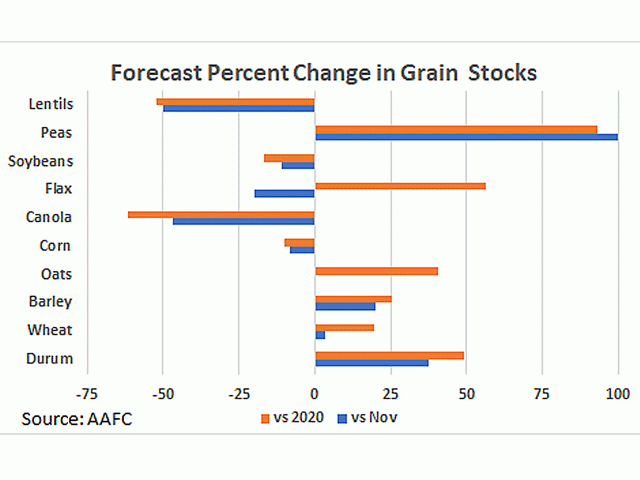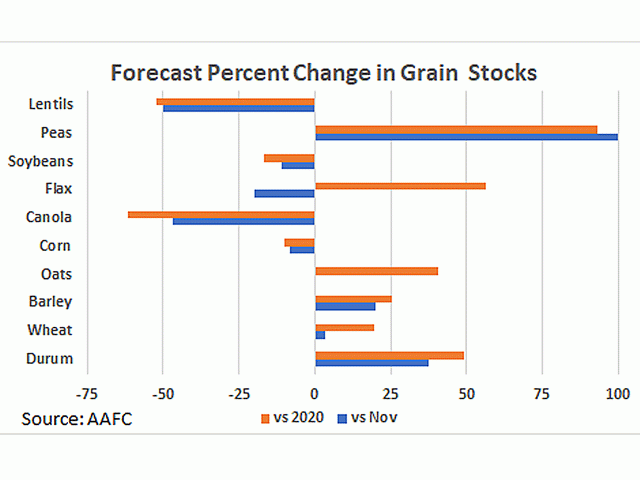Canada Markets
A Look at AAFC's 2020-21 Ending Stocks Estimates
Agriculture and Agri-Food Canada's December supply and demand estimates take into account Statistics Canada's final production estimates released early in the month for the first time.
Looking across the data for all principal field crops, 2020 production was increased by 871,000 metric tons in the December estimates to 98.971 million metric tons from last month's forecasts, with estimates for exports revised higher by 1.295 mmt to 55.140 mmt while domestic use was revised 413,000 mt higher to 46.557 mmt. Ending stocks were revised 465,000 mt lower to 14.120 mmt, down just 1.2% lower that 2019-20, despite the incredible global demand seen across several markets.
This month's wheat exports were revised 200,000 mt higher to 19.650 mmt, a volume that is up 2.7% from 2019-20. An upward revision in production is forecast to offset an increase in both exports and domestic use, with ending stocks revised 200,000 mt higher this month to 5.7 mmt which would be the largest stocks in six years and would be roughly 1 mmt or 21.7% higher than the five-year average.
The current pace of licensed exports as of week 19 is roughly 284,000 mt ahead of the steady pace needed to reach the revised export forecast. This bears watching, with Russian exports to be curtailed by an export tax late in the crop year, while increased competition from Australia can be expected.
AAFC increased their forecast for durum exports by a modest 10,000 mt for a second month in a row to 5.320 mmt, down .4% from the volume achieved in 2019-20. Given current estimates, stocks are forecast to rise by 49.3% year-over-year to 1.1 mmt. As is seen in wheat, the current pace of licensed movement is roughly 198,000 mt ahead of the steady pace needed to achieve this revised forecast.
It is interesting to note that the current forecast shows Canada's all-wheat exports at 24.970 mmt for 2020-21, which remains 1 mmt below the USDA's most recent WASDE forecast.
P[L1] D[0x0] M[300x250] OOP[F] ADUNIT[] T[]
Canola production for 2020 was revised lower by 700,000 mt due to Statistics Canada's data, while the domestic crush was revised 400,000 mt higher to 10.2 mmt and exports were left unchanged from 2019-20 and from the November forecast at 10.2 mmt. As a result, ending stocks were revised sharply lower this month to 1.2 mmt, which would be the lowest realized in eight years and down 52% from the five-year average.
The canola export forecast at 10.2 mmt remains perplexing. This is only 30,000 mt higher than the volume realized in 2019-20, when the current pace of licensed exports through the first 19 weeks of the crop year shows exports 39.8% or 1.365 mmt higher than the same period last crop year, while 1 mmt higher than the steady pace needed to reach the current 10.2 mmt forecast.
This month saw AAFC revise higher their forecast for Canada's soybean exports by 200,000 mt to 4.4 mmt, while revising ending stocks 75,000 mt lower to 600,000 mt. While this is down from the record stocks estimated for 2019-20, this volume would still be above the five-year average of 561,400 mt and appear high at a time when global demand is viewed as exceptional and U.S. stocks could fall to dangerously tight levels.
Canada's corn stocks are forecast to fall by 260,000 mt year-over-year to 2.3 mmt, roughly equal to the five-year average. An increase in export demand to 1.3 mmt, a lower revision of 2020 production plus an increase in exports to 1.3 mmt is seen off-setting an increase in imports to 1.5 mmt and a lower revision for feed demand.
Ending stocks for peas and lentils are seen diverging in this month's data, based on Statistics Canada's final production estimates that included an upward revision in dry pea production and a lower revision for lentil production, while export demand for both crops was left unchanged this month.
The dry pea data bears watching. While 2020-21 exports are to reach a volume only slightly higher than the previous crop year, Statistics Canada's data for the first quarter of the crop year or the end of Oct. shows exports up 23.7% from last crop year. As of week 19, bulk exports through licensed facilities are up 226,900 mt or 20% from the same period last crop year.
Lentil exports as of October are up 53% from 2019-20 while lentil exports through licensed channels as of week 19 are up 212,700 mt or 78% from the same period last year, current forecasts show stocks reaching bin-bottom levels by the end of the crop year. The current crop year will be a test of the actual stocks on the Prairies given current demand estimates.
**
DTN 360 Poll
This week's poll asks if you think your area will benefit from increased biofuel production that is expected to take place as a result of Canada's Clean Fuel Standard that is soon to be released.
This poll can be found on your DTN Canada Home Page. We thank you for your input.
Cliff Jamieson can be reached at cliff.jamieson@dtn.com
Follow him on Twitter @CliffJamieson
(c) Copyright 2020 DTN, LLC. All rights reserved.






Comments
To comment, please Log In or Join our Community .